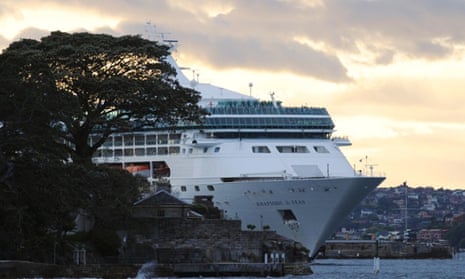The Love Boat has a lot to answer for. For a decade between the late 70s and 80s, my generation endured a weekly dose of cheesy American farce set on a floating singles club. I always imagined it was enough to turn anyone off ever booking a holiday at sea.
How then to explain the fact that, per capita, more Australians now go cruising than Americans, once the world’s most avid mariners? Data compiled by the Cruise Lines Industry Association, the industry’s peak body, show Australian passenger numbers grew by 20% in 2013. By 2016, it’s expected one million Australians will choose to cruise on holiday.
Most likely I’ll be one of them. By some accident I find myself middle-aged and an accidental convert to the joys of ocean-going adventures. Though perhaps not so accidental. Perhaps cruising is in my DNA.
My parents met on a ship. It was back in 1956, aboard the Orient Line’s SS Orion sailing from Melbourne to Tilbury (546 first class, 706 tourist class, 466 crew).
My mother was a 19-year-old accounting machine operator on her first adventure outside Australia. My Canadian father had run away to sea and was working as a steward when he met Audrey Lucille. Romance ensued. They’ve spared me the specifics of their affair but I do know there was one night in Colombo where they cooled off in the phosphorescent waters of the Lakshadweep Sea.

Eventually they reunited in Australia. My father jumped ship in Sydney and was, effectively, an illegal boatperson – though not in the current political sense. Several years later, they had me.
Obviously I am not a Love Boat cruiser. I do not “set a course for adventure, my mind on a new romance”. I’m more the pretentious Drake type: “To dare more boldly, to venture on wider seas”.
My first tastes of seafaring life came in the early 2000s, firstly on a bargain-priced lap of the Baltic aboard the Costa Atlantica and then a brief spell on The World, the notorious cruising condo where paying passengers are treated as steerage by rich residents.
The real epiphany came in 2008 when, coincidentally, I found myself retracing the Love Boat route from Los Angeles to Acapulco via the tourist haunts of Los Cabos and Puerto Vallarta. Far from turning me off ocean escapes, I have never looked back.
The journey was aboard the Prince Albert II (since renamed Silver Explorer), the flagship expedition ship of the Silversea line. As expedition vessels go, the Silver Explorer is a glamorous small liner with Relais & Chateaux-endorsed cuisine and Egyptian cotton suites. No casino, no cabaret, no shuffleboard.
Most of the voyage was spent off the coast of Mexico in the Sea of Cortez, the body of water between the Baja Peninsula and Pacific Mexico famed for its marine biodiversity.
Despite the similar route, our 14-day experience was nothing like The Love Boat. Instead of shipboard romance we found dramatic cactus deserts and oceans seething with marine life.
Day one was spent at sea, cruising shorthand for spa treatments, long lunches, reading and naps. But not on the Silver Explorer, and definitely not in the Gulf of California.
By lunchtime we had spent two hours tailing a brace of blue whales (only the largest creatures on earth, no biggie). Then afternoon siesta was cut short by a chorus line of 2,000 long-backed dolphins leaping in unison across the sea. Some of them even did that Flipper thing where they skitter across the surface on their tails. Incredible.
That trip taught me something essential about cruising; it opens up parts of the world we could never otherwise visit and exposes us to sights we would never otherwise witness. Some of Earth’s most remote wonders can only be witnessed on water.
The Arctic, for example. How else to safely see polar bears in the wild, watch glaciers calve from great frozen walls and icebergs the size of shopping malls float by? And, if you’re lucky, encounter a fata morgana – the mirages, common to polar extremes, that shimmer in the air like fantasy castles.
The Amazon river, one of the last great wilderness adventures, can now be cruised in relative comfort aboard posh ships that depart from the Peruvian frontier town of Iquitos. It is possible to spot sloths and pink dolphins from the glass-walled comfort of a sleek vessel furnished with a barman called Robinson and a menu of rainforest delicacies (the giant river snails are a surprising highlight).
The evolutionary marvels of the Galapagos are also best and most easily appreciated by boat. Ditto the Antarctic, the islands of French Polynesia and, really, anywhere surrounded by water.
In the 21st century, there is no more romantic way to see the far-flung reaches of the globe than by boat. Perhaps that’s part of the reason cruising is booming right now. People want to go further, see more, do something different. And cruising, when it’s done well, offers all that and more.

Comments (…)
Sign in or create your Guardian account to join the discussion